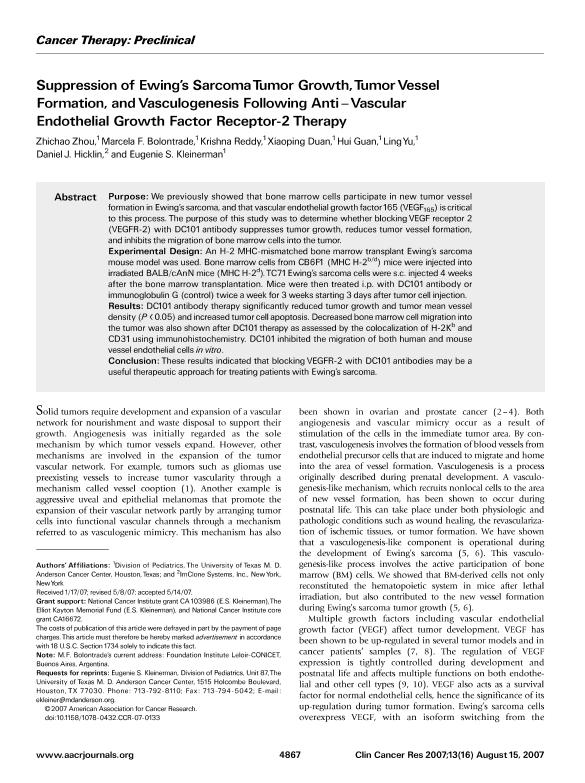Mostrar el registro sencillo del ítem
dc.contributor.author
Zhou, Zhichao
dc.contributor.author
Bolontrade, Marcela Fabiana

dc.contributor.author
Reddy, Krishna
dc.contributor.author
Duan, Xiaoping
dc.contributor.author
Guan, Hui
dc.contributor.author
Yu, Ling
dc.contributor.author
Hicklin, Daniel J.
dc.contributor.author
Kleinerman, Eugenie S.
dc.date.available
2017-12-26T19:44:02Z
dc.date.issued
2007-08
dc.identifier.citation
Guan, Hui; Duan, Xiaoping; Reddy, Krishna; Bolontrade, Marcela Fabiana; Zhou, Zhichao; Kleinerman, Eugenie S.; et al.; Suppression of Ewing's sarcoma tumor growth, tumor vessel formation, and vasculogenesis following anti vascular endothelial growth factor receptor-2 therapy; American Association for Cancer Research; Clinical Cancer Research; 13; 16; 8-2007; 4867-4873
dc.identifier.issn
1078-0432
dc.identifier.uri
http://hdl.handle.net/11336/31578
dc.description.abstract
PURPOSE: We previously showed that bone marrow cells participate in new tumor vessel formation in Ewing's sarcoma, and that vascular endothelial growth factor 165 (VEGF(165)) is critical to this process. The purpose of this study was to determine whether blocking VEGF receptor 2 (VEGFR-2) with DC101 antibody suppresses tumor growth, reduces tumor vessel formation, and inhibits the migration of bone marrow cells into the tumor. EXPERIMENTAL DESIGN: An H-2 MHC-mismatched bone marrow transplant Ewing's sarcoma mouse model was used. Bone marrow cells from CB6F1 (MHC H-2(b/d)) mice were injected into irradiated BALB/cAnN mice (MHC H-2(d)). TC71 Ewing's sarcoma cells were s.c. injected 4 weeks after the bone marrow transplantation. Mice were then treated i.p. with DC101 antibody or immunoglobulin G (control) twice a week for 3 weeks starting 3 days after tumor cell injection. RESULTS: DC101 antibody therapy significantly reduced tumor growth and tumor mean vessel density (P < 0.05) and increased tumor cell apoptosis. Decreased bone marrow cell migration into the tumor was also shown after DC101 therapy as assessed by the colocalization of H-2K(b) and CD31 using immunohistochemistry. DC101 inhibited the migration of both human and mouse vessel endothelial cells in vitro. CONCLUSION: These results indicated that blocking VEGFR-2 with DC101 antibodies may be a useful therapeutic approach for treating patients with Ewing's sarcoma
dc.format
application/pdf
dc.language.iso
eng
dc.publisher
American Association for Cancer Research

dc.rights
info:eu-repo/semantics/openAccess
dc.rights.uri
https://creativecommons.org/licenses/by-nc-sa/2.5/ar/
dc.subject
Ewing´S Sarcoma
dc.subject
Vegf
dc.subject
Progenitor Cell
dc.subject
Vasculogenesis
dc.title
Suppression of Ewing's sarcoma tumor growth, tumor vessel formation, and vasculogenesis following anti vascular endothelial growth factor receptor-2 therapy
dc.type
info:eu-repo/semantics/article
dc.type
info:ar-repo/semantics/artículo
dc.type
info:eu-repo/semantics/publishedVersion
dc.date.updated
2017-12-12T20:02:09Z
dc.identifier.eissn
1078-0432
dc.journal.volume
13
dc.journal.number
16
dc.journal.pagination
4867-4873
dc.journal.pais
Estados Unidos

dc.journal.ciudad
Denville
dc.description.fil
Fil: Zhou, Zhichao. University of Texas; Estados Unidos
dc.description.fil
Fil: Bolontrade, Marcela Fabiana. Consejo Nacional de Investigaciones Científicas y Técnicas. Oficina de Coordinación Administrativa Parque Centenario. Instituto de Investigaciones Bioquímicas de Buenos Aires. Fundación Instituto Leloir. Instituto de Investigaciones Bioquímicas de Buenos Aires; Argentina. University of Texas; Estados Unidos
dc.description.fil
Fil: Reddy, Krishna. University of Texas; Estados Unidos
dc.description.fil
Fil: Duan, Xiaoping. University of Texas; Estados Unidos
dc.description.fil
Fil: Guan, Hui. University of Texas; Estados Unidos
dc.description.fil
Fil: Yu, Ling. University of Texas; Estados Unidos
dc.description.fil
Fil: Hicklin, Daniel J.. ImClone Systems, Inc; Estados Unidos
dc.description.fil
Fil: Kleinerman, Eugenie S.. University of Texas; Estados Unidos
dc.journal.title
Clinical Cancer Research

dc.relation.alternativeid
info:eu-repo/semantics/altIdentifier/url/http://clincancerres.aacrjournals.org/content/13/16/4867.long
dc.relation.alternativeid
info:eu-repo/semantics/altIdentifier/doi/http://dx.doi.org/10.1158/1078-0432.CCR-07-0133
Archivos asociados
